 |
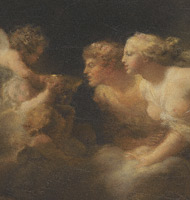
 |
 |
The Fountain of Love (detail), Jean-Honoré Fragonard, about 1785
|
 |
 |
|
Jean-Honoré Fragonard (1732–1806) is associated with the lighthearted Rococo art of prerevolutionary France. It is often assumed that he fell out of favor as tastes shifted toward the more severe, Neoclassical art of the 1770s and 1780s. However, Fragonard created many marketable works during this time that reached a wide audience through engravings and prints.
This exhibition focuses on the most popular compositions of Fragonard's later career: a series of allegories on the theme of love. These share a riveting sense of drama, heightened contrasts of light and shadow, and a restricted palette redolent of nocturnal mystery—characteristics that indicate a new Romantic sensibility. Fragonard's intimate allegories are among the earliest and most eloquent expressions of a new vision of romantic love as an all-consuming experience of near-mystical communion—a vision that was worlds apart from the blithe, libertine spirit of the Rococo era.
|
 |
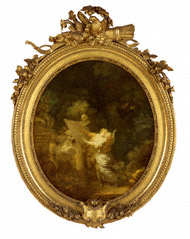
 |
 |
The Oath of Love, Jean-Honoré Fragonard, about 1780–82
|
 |
 |
|
|
 |
In a shadowy garden grove, a young man sweeps his beloved into a passionate embrace. He blindly touches a stone tablet inscribed with the words: "Serment d'aime[r] toute sa vie" ("Oath to love for all one's life"). Holding up the tablet are cupids buoyed by thick clouds of steamy mist rising from a fountain. Garden sculptures look on complicitly: an adolescent Eros leaning on his quiver, two reclining nymphs, and a pair of avid-eyed dolphins.
The Oath of Love was probably the first composition in Fragonard's late allegorical series. Both the 18th-century dress and the garden setting recall earlier cycles on the theme of love, most notably The Progress of Love in the Frick Collection, New York. New elements, however, clearly distinguish The Oath of Love from its precedents: the passionate stances, the theatrical light effects, and the theme of eternal, undying love.
|
 |
 |
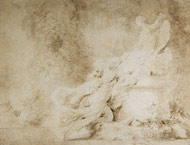
 |
 |
The Invocation to Love, Jean-Honoré Fragonard, about 1781
|
 |
 |
|
Robes flowing in disarray, a girl rushes imploringly toward the base of a statue of Eros. He holds his arm aloft as if to string her all the more desperately on, her inflamed desire wholly captive to his teasing will.
The girl's costume and the relieflike composition signal a new, classicizing direction in Fragonard's art. The model for the lover's pose may be found in ancient Greek and Roman sculptural representations of wild bacchantes (followers of Bacchus, the god of wine), a fitting echo given the theme of love's overpowering irrationality.
The Invocation to Love is the only allegory of Fragonard's late series to have a horizontal format, and the only one that was not reproduced as a popular commercial engraving. The version shown here may have been an advanced preparatory drawing or a record of Fragonard's final painting of the scene.
|
 |
|
Deliriously fixated on the proffered cup, two young lovers race toward love's fountain, the blissful moment of reward held maddeningly, forever, just out of reach. The fountain sends up billowing clouds of mist that dissipate and commingle with the luxuriating foliage above while expectant cupids tumble and roll in the vapor. Fragonard's expressive manipulation of light, shade, and color enhances the intoxicating sense of love's humid, nocturnal transports.
The twinned profiles of the two lovers, reminiscent of ancient cameo portraits, suggest that Fragonard was responding to the Neoclassical tendencies of the 1780s.
Long out of the public eye, this picture resurfaced in 1999, when it was acquired by the Getty Museum. X-ray analysis suggests that it is Fragonard's primary version of the subject, and that a better known and more highly finished painting, The Fountain of Love in the Wallace Collection, London, was painted afterward.
|
 |
 |
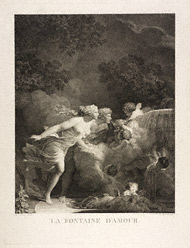
 |
 |
The Fountain of Love, Nicolas-François Regnault after Jean-Honoré Fragonard, after 1785
|
 |
 |
|
Beginning in the mid-1770s, Fragonard was actively involved in having his compositions published as prints. Three of the four allegories of love in this exhibition were reproduced as engravings. His work was therefore able to reach a large, diverse public, even though he had stopped exhibiting in the French Royal Academy's biennial Salon after 1767.
This print incorporates elements from both painted versions of The Fountain of Love, suggesting that it may have been made when both works were still in Fragonard's studio. The fountain's streaming water and the plant (in the lower-left corner) only appear in the Getty's version. Other details, such as the trailing foot of the male figure, apparently come from the Wallace Collection's version.
|
 |
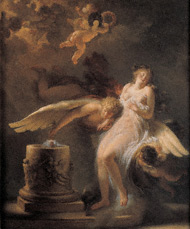
 |
 |
The Sacrifice of the Rose, Jean-Honoré Fragonard, about 1785–88
|
 |
 |
|
|
 |
Like an angelic emissary, Eros hovers over an altar as he torches the rose placed there by a swooning, disheveled girl, whom he nestles in his wing. The young girl's rapturous pose makes it apparent that it is her virginity that is being sacrificed here. Celebrating her ecstasy, cupids descend through a break in the clouds.
The Sacrifice of the Rose is the only one of Fragonard's allegories not explicitly set in a garden or parklike setting. In the version shown here, the background consists merely of shadows and vapors.
Probably conceived last in Fragonard's series, The Sacrifice of the Rose boasts an elevated art historical pedigree. The girl recalls The Ecstasy of Saint Teresa, a statue in Rome by Gian Lorenzo Bernini, while Eros and the cupids derive from paintings by Peter Paul Rubens and Rembrandt. Such references to northern European and Italian Baroque art testify to Fragonard's eclectic tastes and may also indicate a break from the Neoclassical tendencies he flirted with in The Invocation to Love and The Fountain of Love.
|
 |
 |

 |
 |
The Kiss, Jean-Honoré Fragonard, about 1785
|
 |
 |
|
The exhibition includes several other complementary works by Fragonard.
Although never executed as a painting, the composition shown here relates thematically to the allegories. In a grove of cypresses—conjuring both a cemetery and the garden settings of the allegories—a sarcophagus has been broken open. Inside, two lovers' spirits, flowing out of the urn in which their ashes were stored, are revived by Cupid's torch.
The promise made in The Oath of Love, "to love all one's life," has not only been kept, but extended into a blissful afterlife.
|
 |
|
The exhibition also includes a selection from the extraordinary public and private collections of the art of Fragonard in the Los Angeles area.
|
 |








